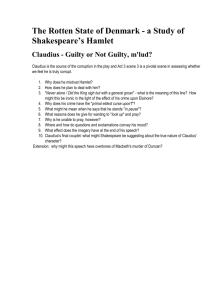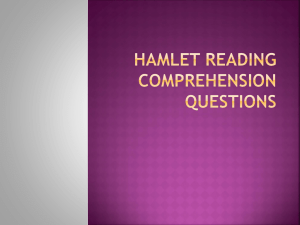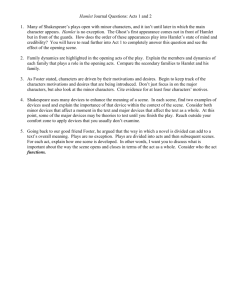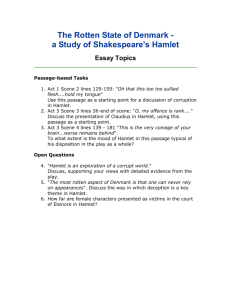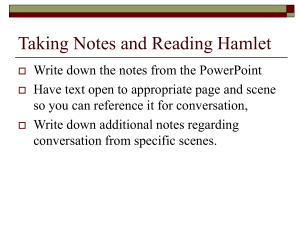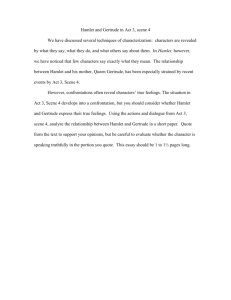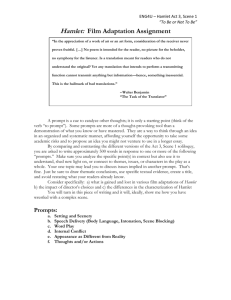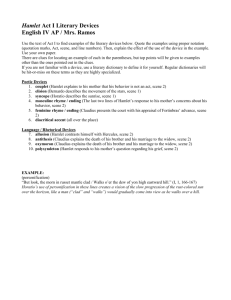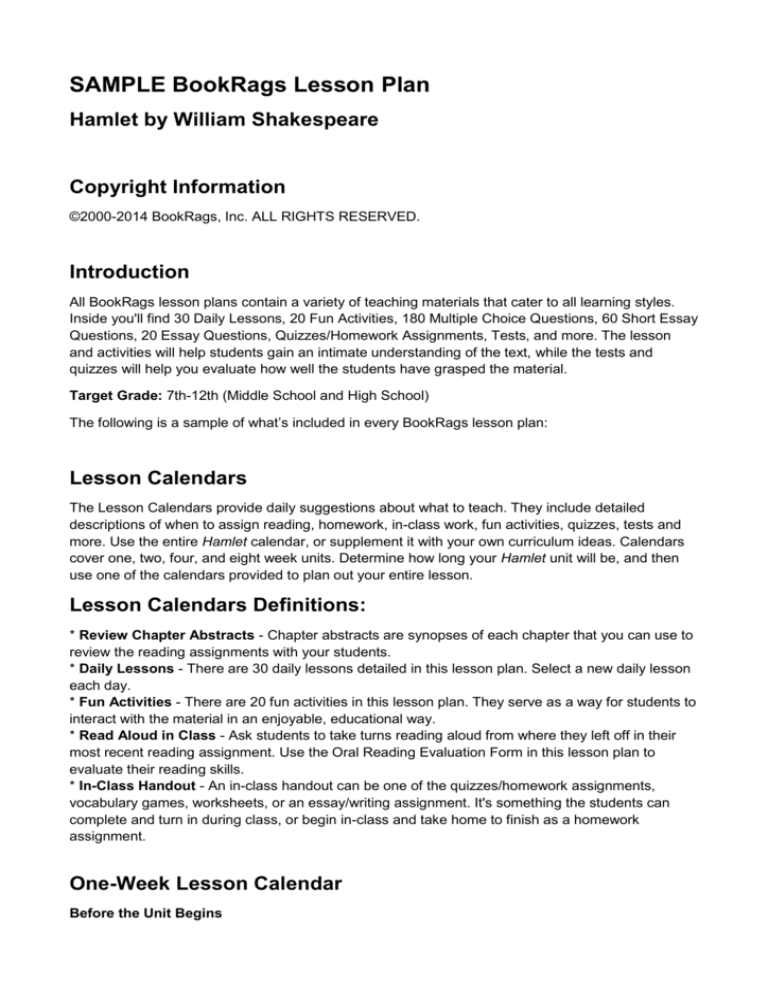
SAMPLE BookRags Lesson Plan
Hamlet by William Shakespeare
Copyright Information
©2000-2014 BookRags, Inc. ALL RIGHTS RESERVED.
Introduction
All BookRags lesson plans contain a variety of teaching materials that cater to all learning styles.
Inside you'll find 30 Daily Lessons, 20 Fun Activities, 180 Multiple Choice Questions, 60 Short Essay
Questions, 20 Essay Questions, Quizzes/Homework Assignments, Tests, and more. The lesson
and activities will help students gain an intimate understanding of the text, while the tests and
quizzes will help you evaluate how well the students have grasped the material.
Target Grade: 7th-12th (Middle School and High School)
The following is a sample of what’s included in every BookRags lesson plan:
Lesson Calendars
The Lesson Calendars provide daily suggestions about what to teach. They include detailed
descriptions of when to assign reading, homework, in-class work, fun activities, quizzes, tests and
more. Use the entire Hamlet calendar, or supplement it with your own curriculum ideas. Calendars
cover one, two, four, and eight week units. Determine how long your Hamlet unit will be, and then
use one of the calendars provided to plan out your entire lesson.
Lesson Calendars Definitions:
* Review Chapter Abstracts - Chapter abstracts are synopses of each chapter that you can use to
review the reading assignments with your students.
* Daily Lessons - There are 30 daily lessons detailed in this lesson plan. Select a new daily lesson
each day.
* Fun Activities - There are 20 fun activities in this lesson plan. They serve as a way for students to
interact with the material in an enjoyable, educational way.
* Read Aloud in Class - Ask students to take turns reading aloud from where they left off in their
most recent reading assignment. Use the Oral Reading Evaluation Form in this lesson plan to
evaluate their reading skills.
* In-Class Handout - An in-class handout can be one of the quizzes/homework assignments,
vocabulary games, worksheets, or an essay/writing assignment. It's something the students can
complete and turn in during class, or begin in-class and take home to finish as a homework
assignment.
One-Week Lesson Calendar
Before the Unit Begins
Homework: Read through Act 1, Scene 5 of Hamlet.
Day 1 - Introduce Day 2 - Review
Day 3 - Quiz
Day 4 - Review
Day 5 - Final Test
Unit
Unit
Unit
Review Chapter
Review Chapter
Review Chapter
Review Chapter
Test
Abstracts up to Act Abstracts up to Act Abstracts up to Act Abstracts up to Act
1, Scene 5
3, Scene 3
4, Scene 4
5, Scene 2
1 Lesson from
1 Lesson from
Quiz
1 Lesson from
Daily Lessons 1-8 Daily Lessons 7-16 1 Lesson from
Daily Lessons 241 Fun Activity from 1 In-Class Handout Daily Lessons 17- 30
Fun Activities 1-10 Homework
23
1 In-Class Handout
Students Read
Assignment: Read 1 In-Class Handout Homework
Aloud in Class
through Act 4,
1 Fun Activity from Assignment: Study
Homework
Scene 4 and
Fun Activities 2-10 for the test
Assignment: Read choose a
Homework
through Act 3,
homework
Assignment: Read
Scene 3
assignment from through Act 5,
one of the Daily
Scene 2 and assign
Lessons
an essay, due the
week following the
test
…
Chapter Abstracts
Chapter abstracts are short descriptions of events that occur in each chapter. They highlight major
plot events and detail the important relationships and characteristics of characters and objects. The
Chapter Abstracts can be used to review what the students have read, or to prepare the students for
what they will read. Hand the abstracts out in class as a study guide, or use them as a "key" for a
class discussion. They are relatively brief, but can serve to be an excellent refresher of the text for
either a student or teacher.
Act 1, Scene 1 Abstract
* It is a cold night outside a castle in Elsinore, Denmark.
* Men are standing on watch and talking about seeing a "thing."
* One of them has brought Horatio, Prince Hamlet's friend, to witness the "thing."
* The "thing" is a ghost that walks at night.
Act 1, Scene 2 Abstract
* Horatio says the ghost looks like Denmark's last king (Hamlet's father) who recently died.
* They try to speak to the ghost. It looks like it will respond, but then the cock crows and the ghost
disappears.
* Horatio decides to tell Hamlet about the ghost.
Act 1, Scene 3 Abstract
* Inside the castle, King Claudius gives a speech, describing the situation: his brother died, he took
his brother's throne, and married his brother's widow, Gertrude.
* The country is also in an ongoing struggle with Norway, and Fortinbras, the prince of Norway, is
making threats.
* Laertes, son of Claudius's counselor Polonius, returned to Denmark for Claudius's coronation, and
now wants to go back to school. Claudius gives permission once he is sure that Polonius has given
permission.
…
Character Descriptions
This section provides a short description of all the major characters in the play. These can be
printed out and used as an individual study guide for students, a "key" for leading a class
discussion, a summary review prior to exams, or a refresher for an educator.
Characters
Gravediggers - These characters are rustic workers who have been at their job ever since the
prince was born. They are the ones who turn up a reminder of "poor Yorick."
Guildenstern - This character is one of the main character's close friends who is summoned to find
out what is causing the prince's strange behavior.
Hamlet (Prince Hamlet of Denmark) - This central character of the play pretends to be insane
while formulating a plan to avenge the last king's murder.
Horatio - This character is the main character's closest friend, a former fellow-student who has
come to Elsinore for the funeral of the old king.
…
Object Descriptions
This section provides a short description of all the major objects in the play. This can be printed out
as a study guide for students, used as a "key" for leading a class discussion, or you can jump to the
quiz/homework section to find worksheets that incorporate these descriptions into a variety of
question formats.
Objects
Elsinore Castle - This is the home of the royal family in Denmark; it is well guarded because of
recent threats, but that does not stop a ghost from roaming the grounds.
Armor, Beaver, Truncheon - These are the distinctive elements that help Horatio and the others
recognize the identity of the ghost.
Sentinel - This position stands guard at a gate or passageway. The ghost visits a few of these
during their midnight watches.
Wittenberg - This is a city in Germany where Hamlet and Horatio go to school.
Confession - This religious ritual cleanses the soul of sin and grants the deceased spirit access to
heaven. Because the last king died without the chance to go through this ritual, his soul is doomed.
…
Multiple Choice Questions
The 180 Multiple Choice Questions in this lesson plan will test a student's recall and understanding
of Hamlet. Use these questions for quizzes, homework assignments or tests. The questions are
broken out into sections, so they focus on specific acts within Hamlet. This allows you to test and
review the play as you proceed through the unit.
1. Where is Elsinore?
(a) France.
(b) England.
(c) Denmark.
(d) Italy.
2. What time of day is it when the play starts?
(a) Morning.
(b) After dinner.
(c) Noon.
(d) Late at night.
3. At the start of the play, what are Francisco and Bernardo doing?
(a) They are fighting in a battle.
(b) They are getting ready to go to sleep.
(c) They are on watch.
(d) They are eating a meal together.
4. Who does the ghost in Act 1, Scene 1 look like?
(a) The prince, Hamlet.
(b) The Queen.
(c) The king who just died.
(d) The king's advisor, Polonius.
5. How many times does the ghost appear in Act 1, Scene 1?
(a) Twice.
(b) Three times.
(c) Four times.
(d) Once.
…
Multiple Choice Key
1. C
2. D
3. C
4. C
5. A
…
Short Answer Questions
The 180 Short Answer Questions are intentionally identical to the 180 Multiple Choice Questions.
This section simply offers teachers another format with which to test students.
1. Where is Elsinore in Act 1, Scene 1?
2. What time of day is it when the play starts?
3. At the start of the play, what are Francisco and Bernardo doing?
4. Who does the ghost in Act 1, Scene 1 look like?
5. How many times does the ghost appear in Act 1, Scene 1?
…
Short Answer Questions Key
1. Where is Elsinore in Act 1, Scene 1?
Denmark.
2. What time of day is it when the play starts?
Late at night.
3. At the start of the play, what are Francisco and Bernardo doing?
They are on watch.
4. Who does the ghost in Act 1, Scene 1 look like?
The king who just died.
5. How many times does the ghost appear in Act 1, Scene 1?
Twice.
…
Short Essay Questions
The 60 Short Essay Questions listed in this section require a one to two sentence answer. They ask
students to demonstrate a deeper understanding of Hamlet by describing what they've read, rather
than just recalling it. The short essay questions evaluate not only whether students have read the
material, but also how well they understand and can apply it. They require more critical thinking than
the multiple choice questions, but are shorter than the essay questions.
1. What is the setting (time and place) at the beginning of the day?
2. Who does the Ghost in Act 1, Scene 1 look like?
3. Does the Ghost at the beginning of the play talk to the watchers?
4. At the end of Act 1, Scene 1, what does Horatio say he will do next?
5. The first time Claudius appears on stage, he gives a speech describing the current state of
affairs in Denmark. He identifies and explains three major events. What are those events?
…
Short Essay Questions Key
1. What is the setting (time and place) at the beginning of the day?
As the play begins, it is a dark, cold night outside the castle in Elsinore, Denmark.
2. Who does the Ghost in Act 1, Scene 1 look like?
The Ghost at the beginning of the play looks like the recently deceased King of Denmark; it is
dressed the way the king dressed when he battled against Norway.
3. Does the Ghost at the beginning of the play talk to the watchers?
The Ghost looks like it will speak, but the cock crows and the ghost disappears.
4. At the end of Act 1, Scene 1, what does Horatio say he will do next?
At the end of Act 1, Scene 1, Horatio says he will tell Hamlet about the ghost.
5. The first time Claudius appears on stage, he gives a speech describing the current state of
affairs in Denmark. He identifies and explains three major events. What are those events?
The first time Claudius appears on stage, he identifies three major events:
1. The death of the last king and Claudius's ascent to the throne
2. Claudius's marriage to Queen Gertrude
3. The ongoing battles with Norway
…
Essay Topics
These 20 Essay Questions/Writing Assignments can be used as essay questions on a test, or as
stand-alone essay topics for a take-home or in-class writing assignment on Hamlet. Students should
have a full understanding of the unit material in order to answer these questions. They often include
multiple parts of the work and ask for a thorough analysis of the overall text. They nearly always
require a substantial response. Essay responses are typically expected to be one (or more) page(s)
and consist of multiple paragraphs, although it is possible to write answers more briefly. These
essays are designed to challenge a student's understanding of the broad points in a work,
interactions among the characters, and main points and themes of the text. But, they also cover
many of the other issues specific to the work and to the world today.
1. Compare and contrast the characters of Gertrude and Ophelia, focusing on the following
points:
-- To what extent is each of them a victim of what happens?
-- To what extent does each of them cause what happens?
-- Does Gertrude affect Hamlet's relationship with Ophelia? If so, how? Does Ophelia affect
Hamlet's relationship with Gertrude? If so, how?
-- How do the other men in the play treat Gertrude and Ophelia? How does that contribute to our
overall sense of them? Focus specifically on the ghost, Claudius, Laertes, and Polonius.
-- Does it matter that these are essentially the only two female characters in the play? Why?
2. One of the major themes in the play is connected to ears, hearing, and trusting what you
hear. Identify one or two important moments in each act when that theme comes up. Explain
the moment, why it is important, and how it contributes to the overall theme.
3. The question of suicide comes up repeatedly in the play. Hamlet mentions it on multiple
occasions and Ophelia's death is potentially a suicide and questionable enough that her
funeral rites are "maimed." Discuss the play's treatment of suicide, focusing on the following
points:
-- How is suicide presented? Is it a good thing or a bad thing?
-- Are there universal truths about death and suicide, as Hamlet seems to suggest in the "To be or
not to be" speech? Or does the play contradict that by adding in Ophelia's suicide?
-- Do you think Ophelia does commit suicide? Why or why not?
-- Do you think Hamlet is essentially committing suicide at the end of the play? Why or why not?
…
Daily Lessons
This section of the lesson plan contains 30 Daily Lessons. Daily Lessons each have a specific
objective and offer at least three (often more) ways to teach that objective. Lessons include
classroom discussions, group and partner activities, in-class handouts, individual writing
assignments, at least one homework assignment, class participation exercises and other ways to
teach students about Hamlet in a classroom setting. You can combine daily lessons or use the
ideas within them to create your own unique curriculum. They vary greatly from day to day and offer
an array of creative ideas that provide many options for an educator.
Lesson 1
Objective: Act 1, Scene 1. The objective of this lesson is to present students with some basics
about Shakespeare and Shakespeare's plays.
1) Teacher Lecture: Explain to students that Shakespeare's plays are written in five acts. Explain to
students that most plays today are performed in two or three acts. If students have ever seen a play
with an intermission, that intermission generally comes between the acts. Within each act, the play
is divided into scenes. There is no minimum number of scenes in an act, and in Hamlet students will
see that some acts have only a few scenes and other acts have many scenes. Point out to students
that the proper way to identify something within the text is to use the act number and scene number:
"In Act 2, Scene 2, Hamlet says...." If the version of the text you are using includes line numbers,
you may also want to explain those.
2) Class Discussion: Explain that Shakespeare's plays are generally divided into three groups:
comedies, tragedies, and histories. Ask students to guess what the differences might be between
the three, but encourage them to come up with stronger answers than "one is happy and one is
sad." Explain that the histories are loosely based on historical facts. The comedies and the
tragedies follow a similar basic structure, which students should take notes on. Comedies start with
a status quo, descend into chaos, and then resolve the chaos, usually through marriage or another
romantic happy ending. Tragedies, on the other hand, start with the status quo, descend into chaos,
and then resolve the chaos through the death of many or most of the significant characters in the
play.
3) Group Activity: Divide the class into groups and give each group a list of the titles of
Shakespeare's plays. There are many versions of the list available -- try to find one that does not
include the subtitles or labels such as "The Tragedy of Hamlet, Prince of Denmark." Invite the
groups to label each play as a comedy, tragedy, or history based on its title alone. Some should be
quite obvious (Comedy of Errors) and some will be less so. Ask students to share their predictions
with the class, and then provide the students with a list that already has the plays sorted by type
(many of these are also available online). Point out that Hamlet is a tragedy and ask students to
keep that in mind as they start reading the play.
4) Homework: Ask students to take the virtual tour of the Globe Theater, or provide students with a
picture or diagram of the Globe. Explain to students that the stage of the Globe was basically bare,
except for a couple of pillars (as seen in the virtual tour) and a few chairs or other furniture items
that can be brought onstage. Also note that the plays were done without stage lighting, which did
not exist in Shakespeare's times. In fact, plays were performed in the middle of the day to use
sunlight. Ask students to write one to two paragraphs on the following topic: Imagine you are
Shakespeare. You are writing a play that you know will be performed on a mostly bare stage without
any special lighting effects. How is that going to affect what you write? How will you let people know
the setting of your scenes?
Lesson 2
Objective: Act 1, Scene 1. The objective of this lesson is to introduce the concept of foreshadowing
and help students identify elements of foreshadowing in this first scene.
1) Partner Activity & Discussion: Divide the class into pairs. Ask each pair to read aloud the
opening of the play, with one person reading Bernardo and one reading Francisco. They should
read up until other characters come onstage. When students have finished reading, ask them to
explain to you what is happening in that part of the scene. While they may struggle with some of the
language, they should be able to understand the basic elements of the scene: it's dark, it's cold, a
man is standing guard and another man comes to relieve him. Ask students what kind of mood that
opening sets. If students struggle to answer, use the following points to help them: what if the first
man said "Hi, nice to see you" instead of "Who's there?" What if the first man was hanging out,
relaxing, instead of standing guard? The tone of the opening is ominous or uneasy. Explain that this
is foreshadowing, the presentation of hints or clues that warn the reader about what might happen
later in the work.
2) Class Activity: Ask students to work with their partner to read through the rest of the scene and
identify other elements of foreshadowing. When students have read through the scene, make a list
of the elements on the board. The list may include: the setting (midnight, cold weather), the ghost,
the fact that the ghost looks like the dead king, the news about Fortinbras and Norway, the way the
men react to the ghost (they speak of being frightened, troubled, sick at heart). You may wish to
point out that later in the play, someone will use the phrase "something rotten in the state of
Denmark," but that Shakespeare has actually created that sense of trouble or rottenness in this first
scene.
3) Homework: Ask students to write the scene where Marcellus first tells Horatio about the ghost.
They may write it as a script or as a story, but they should include all the facts about the ghost that
are stated in this first scene of the play, and make sure that Horatio reacts appropriately, based on
his attitude when he first enters in Act 1, Scene 1.
Lesson 3
Objective: Act 1, Scene 2. The objective of this lesson is for students to analyze the second scene
in the play to consider how Shakespeare builds a sense of uneasiness before even introducing the
main character.
1) Class & Group Activity: Explain to the students that the dead king, the one the ghost looks like,
was also named Hamlet, and that king was the father of the main character, who they have yet to
see. Once they understand that, ask students to look over Claudius's speech at the start of Act 1,
Scene 2, up until he says "For all, our thanks." While they read through, ask them to make three
columns of words: happy or positive words, unhappy or negative words, and words they do not
understand. For example, "joy" would be a happy word, "death" would be an unhappy word, and
"auspicious" might be a word they do not know. Once students have made their list, move them into
groups of three to four to compare lists. Tell the students their first goal is to move all the words out
of the "unknown" column. They may ask their classmates, ask the teacher, or look it up in a
dictionary if one is available. Once students have cleared their unknown columns, ask them to
compare their happy and unhappy columns and see if they agree with their group-mates.
Point out that Claudius is talking about two very different things in this part of the speech: a funeral
and a wedding. Using the lists of words the students have made, help them see how Shakespeare
has mixed those words together to create a sort of muddled and disjointed sense of how things are
in Denmark. Then point out, if students have not yet realized it, that Claudius's marriage was to his
former sister-in-law, the widow of the dead king. Ask students what they think about that. Remind
students that they are being presented with all this information before they see Hamlet.
2) Class Discussion: Ask students: Why do they think Shakespeare started the play with the first
scene instead of with this one? Why not start with the scene that actually introduces more of the
main characters, since Horatio is really the only character from Scene 1 that will play a major role
later on? Why is it important that the audience sees the ghost before hearing Claudius's speech?
3) Homework: Ask students to create a character analysis chart with four columns: character, what
is known about them, what I think about them, questions I have about them. Ask students to
complete this chart for the following characters: Horatio, Claudius, Fortinbras, Gertrude, Laertes,
Polonius, and Hamlet (the prince, not the dead king). Point out that they may not know much about
the characters yet, but they should be able to draw some conclusions based on the character's
speech and behavior and what other characters say about them. The "what I think about them" is a
place to share their opinions based on what they have read so far. Tell students that they will be
returning to this chart to add to it as the play continues.
…
Fun Activities
Fun Classroom Activities differ from Daily Lessons because they make "fun" a priority. The 20
enjoyable, interactive classroom activities that are included will help students understand Hamlet in
fun and entertaining ways. Fun Classroom Activities include group projects, games, critical thinking
activities, brainstorming sessions, writing poems, drawing or sketching, and countless other creative
exercises. Many of the activities encourage students to interact with each other, be creative and
think "outside of the box," and ultimately grasp key concepts from the text by "doing" rather than
simply studying. Fun activities are a great way to keep students interested and engaged while still
providing a deeper understanding of Hamlet and its themes.
1. Shakespearean Stars
Research one of the many actors who have become famous because of their performances of
Shakespeare, such as Richard Burbage, Edwin Booth, John Barrymore, Edith Evans, or Peggy
Ashcroft. Make sure you choose someone with a substantial background in Shakespeare (e.g., not
Leonardo DiCaprio because he did Romeo and Juliet once). Create a poster that includes the
following:
-- actor's name
-- actor's year of birth and death (if appropriate)
-- what Shakespeare plays or films they did
-- which role, if any, they were especially famous for
-- a photograph or drawing of the actor
We will use the posters to decorate the classroom.
2. King Gertrude? Princess Hamlet?
Did you know that when Shakespeare's plays were first performed all the parts were played by
men? Even the female characters were played by young boys whose voices were high enough to
sound like girls. So Ophelia would have been played by a boy. Centuries later, women decided that
it wasn't fair to let the men have all the good parts and many productions were staged with some or
all of the parts played by women.
Write a short paragraph on the following topic: If you had to choose, would you rather see an allboys production of Hamlet, as it was done during Shakespeare's time, or an all-girls production of
Hamlet, as has been done in more recent history? Why?
3. Enjoy the show!
If possible, go see a live production of Hamlet, or screen a movie version in class. After you've seen
it, discuss the following with your classmates:
-- How was the production different from what you expected?
-- How was the production similar to what you expected?
-- Did the actors look the way you imagined the characters to look? Why or why not?
-- What was your favorite moment in the production?
-- What was a moment that you thought did not work very well or was not very interesting, powerful
or effective?
-- Did this production change your understanding or opinion of the play? Why or why not?
You can also write a review of the production that answers these questions.
…
Each lesson plan also includes the following:
Evaluation Forms
Use the Oral Reading Evaluation Form when students are reading aloud in class. Pass the forms
out before you assign reading, so students will know what to expect. You can use the forms to
provide general feedback on audibility, pronunciation, articulation, expression and rate of speech.
You can use this form to grade students, or simply comment on their progress.
Use the Writing Evaluation Form when you're grading student essays. This will help you establish
uniform criteria for grading essays even though students may be writing about different aspects of
the material. By following this form you will be able to evaluate the thesis, organization, supporting
arguments, paragraph transitions, grammar, spelling, punctuation, etc. of each student's essay.
Quizzes/Homework Assignments
The Quizzes/Homework Assignments are worksheets that can be used in a variety of ways. They
pull questions from the multiple choice and short essay sections, the character and object
descriptions, and the chapter abstracts to create worksheets that can be used for pop quizzes, inclass assignments and homework. Periodic homework assignments and quizzes are a great way to
encourage students to stay on top of their assigned reading. They can also help you determine
which concepts and ideas your class grasps and which they need more guidance on. By pulling
from the different sections of the lesson plan, quizzes and homework assignments offer a
comprehensive review of Hamlet in manageable increments that are less substantial than a full test.
Tests
Use the Test Summary page to determine which pre-made test is most relevant to your students'
learning styles. This lesson plan provides both full unit tests and mid-unit tests. You can choose
from several tests that include differing combinations of multiple choice questions, short answer
questions, short essay questions, full essay questions, character and object matching, etc. Some of
the tests are designed to be more difficult than others. Some have essay questions, while others are
limited to short-response questions, like multiple choice, matching and short answer questions. If
you don't find the combination of questions that best suits your class, you can also create your own
test on Hamlet.
Create Your Own Quiz or Test
You have the option to Create Your Own Quiz or Test. If you want to integrate questions you've
developed for your curriculum with the questions in this lesson plan, or you simply want to create a
unique test or quiz from the questions this lesson plan offers, it's easy to do. Cut and paste the
information from the Create Your Own Quiz or Test page into a Word document to get started.
Scroll through the sections of the lesson plan that most interest you and cut and paste the exact
questions you want to use into your new, personalized Hamlet lesson plan.


